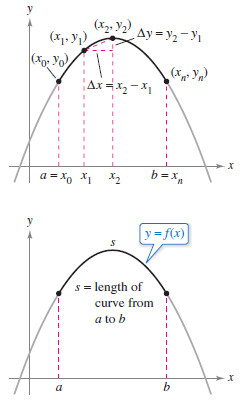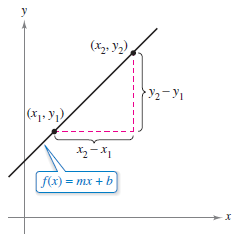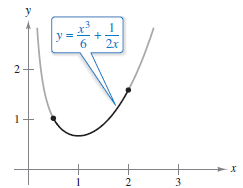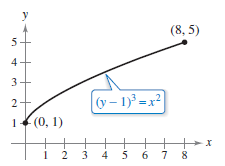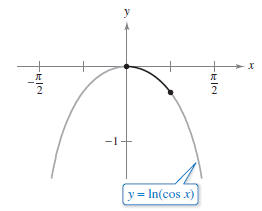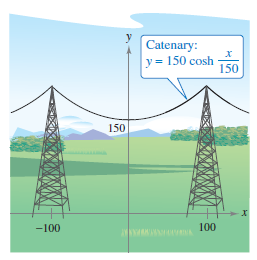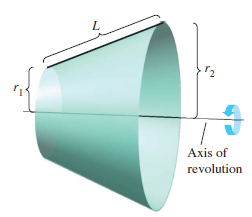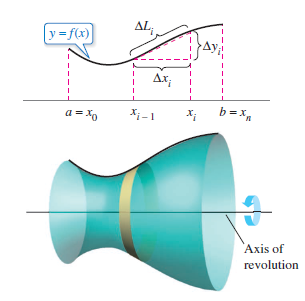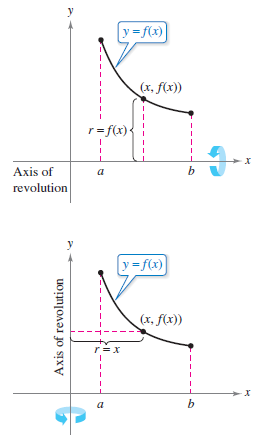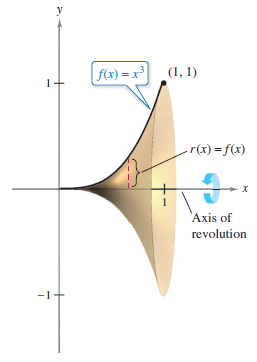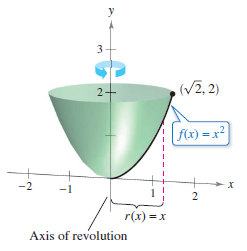Calculus II 07.04 Arc Length and Surfaces for Revolution
| Previous | Calculus II 07.03 Volume The Shell Method |
| Next | Calculus II 07.05 Work |
Contents
7.4 Arc Length and Surfaces for Revolution
- Find the arc length for a smooth curve.
- Find the area for a rotate surface.
Arc Length
|
Arc lengths are found by using integrals and the areas for rotated surfaces. In either case, an arc (a segment of a curve) is approximated by straight line segments whose lengths are given by the familiar Distance Formula
A rectifiable curve is one that has a finite arc length. The function \(f\)'s graph is rectifiable between \((a,f(a))\) and \(b,f(b))\) and that \(f^{\prime }\) be continuous on \([ a,b ] \). Such a function is continuously differentiable on \([ a,b ] \), and its graph on the interval \([ a,b ] \) is a smooth curve. Consider a function \(y=f(x)\) that is continuously differentiable on the interval \([ a,b ] \). You can approximate \(f\)'s graph by \(n\) line segments whose endpoints are determined by the partition
as shown in Figure 7.37. By letting \(\Delta x_{i}=x_{i}-x_{i-1}\) and \(\Delta y_{i}=y_{i}-y_{i-1}\), you can approximate the graph's length by
This approximation improves as \(\left \| \Delta \right \|\rightarrow 0(n\rightarrow \infty )\). The graph's length is
Because \(f^{\prime }(x)\) exists for each \(x\) in \((x_{i-1},x_{i})\), the Mean Value Theorem guarantees that \(c_{i}\) exists in \((x_{i-1},x_{i})\) such that
Because \( f^{\prime }\) is continuous on \([ a,b ] \), if follows that \( \sqrt{1+ [f^{\prime }(x) ]^{2} } \) is also continuous (and therefore integrable) on \([ a,b ] \), which implies that
where \(s\) is called the arc length for \(f\) between \(a\) and \(b\). |
Definition 7.4.1 Arc Length
Let the function \(y=f(x)\) represent a smooth curve on the interval \([ a,b ] \). The arc length for the graph \(f\) between \(a\) and \(b\).
- $$S = \int_{a}^{b} \sqrt{ 1 + [ f^{\prime }(x)]^{2}} \: dx .$$
Similarly, for a smooth curve \(x=g(y)\), the arc length for the graph \(g\) between \(c\) and \(d\) is
- $$ S = \int_{c}^{d} \sqrt{ 1 + \left[ g^{\prime }(y) \right]^{2}} \: dy .$$
- To see how arc length can be used to define trigonometric functions, see the article “Trigonometry Requires Calculus, Not Vice
Versa” by Yves Nievergelt in UMAP Modules.
Example 7.4.1 Line Segment Length
|
Find the arc length from \((x_{1},y_{1})\) to \((x_{2},y_{2})\) on the graph
as shown in Figure 7.4.2
it follows that
which is the formula for the distance between two points in the plane. |
Example 7.4.2 Finding a Bowed Arc Length
|
Find the arch length for the graph
on the interval \([ \frac{1}{2}, 2 ] \), as shown in Figure 7.4.3
yields the arc length formula
|
Example 7.4.3 Finding Arc Length
|
Find the arc length for the graph, \( (y-1)^{3}=x^{2} \) over the interval \( [ 0,8 ] \), as shown in Figure 7.4.4.
The \(x\)-interval \( [ 0,8 ] \) corresponds to the \(y\)-interval \( [ 1,5 ] \), and the arc length is
|
Example 7.4.4 Finding Arc Length
|
Find the arc length for the graph<
from \(x=0\) to \(x=\pi / 4 \), as shown in Figure 7.4.5
yields the arc length
|
Example 7.4.5 Cable Length with Sag
|
An electric cable is hung between two towers that are 200 feet apart, as shown in Figure 7.4.6. The cable takes a catenary shape whose equation is
Find the arc length for the cable between the two towers.
and
This yields the cable's arc length
|
Area for a Rotated Surface
In Sections 7.2 and 7.3 , integration was used to calculate the volume for a rotated solid. Here integration is used to find the area for a rotated surface.
Definition 7.4.2 A Rotated Surface
|
|
When the graph for a continuous function is revolved about a line, the resulting surface is a rotated surface. The area for a rotated surface is calculated using the formula for a right circular cone's frustum area. Consider the line segment in Figure 7.4.7, where \(L\) is the line segment length, \(r_{1}\) is the radius at the left end, and \(r_{2}\) is the radius at the right end. When the line segment is rotated about the axis, it forms a frustum for a right circular cone, with
where
Consider a function \(f\) that has a continuous derivative on the interval \([ a,b ] \). The graph for \(f\) is rotated about the \(x\)-axis to form the surface shown in Figure 7.4.8. Let \(\Delta \) be a partition over \([ a,b ]\) with subintervals \(\Delta x_{i} \) wide. Then the line
generates a frustum. Let \(r_{i}\) be the average radius. By the Intermediate Value Theorem[1], a point \(d_{i}\) exists (in the \(i\)th subinterval) such that
The lateral surface area \(\Delta S_{i}\) for the frustum is
By The Mean Value Theorem [2], a point \(r_{i} \) exists in \(x_{i-1},x_{i}) \) that
Therefore, \( \Delta S_{i} = 2 \pi f(d_{i}) \sqrt{1+[f^{\prime }(c_{i})]^{2} }\Delta x_{i} \), and the total surface area can be approximated by
The limit as \( \| \Delta \|\rightarrow 0(n \to \infty ) \) is
The vertical formula for \(S\), the graph is rotated about the \(y\)-axis, has \(2\pi x\) for the circumference and \(r=x\) for the radius. The horizontal formula for \(S\), the graph is rotated about the \(x\)-axis, has \(2\pi f(x)\) for the circumference and \(r=f(x)\) for the radius. See Figure 7.4.9. By appropriately adjusting \(r\), you can generalize the formula to cover any horizontal or vertical axis as indicated in the next definition. |
Definition 7.4.3 Rotated Surface Area
Let \(y=f(x)\) have a continuous derivative over the interval \([a,b]\). Rotating \(f\)'s graph about a horizontal or vertical axis produces an area \(S\) with the formula
- $$ S = 2 \pi \int_{a}^{b} r(x) \sqrt{1+ \left[ f^{\prime }(x) \right]^{2} } dx \:\:\:\: \color{red}{y \text{ is a function for }x} $$
where \(r\) is the distance between \(f\)'s graph and the axis. If \(x=g(y)\) on the interval \([c,d]\), then the surface area is
- $$ S = 2 \pi \int_{c}^{d} r(y) \sqrt{1+ \left[ g^{\prime }(y) \right]^{2} } dy \:\:\:\: \color{red}{ x \text{ is a function for }y}$$
where \(r(y)\) is the distance between \(g\)'s graph and the axis. The formulas in this definition are sometimes written as
- $$ S = 2 \pi \int_{a}^{b} r(x)\:ds \:\:\:\: \color{red}{ y \text{ is a function for }x}$$
and
- $$S = 2 \pi \int_{c}^{d} r(y)\:ds \:\:\:\: \color{red}{x \text{ is a function for }y}$$
where
- $$ds=\sqrt{1+ \left[ f^{\prime }(x) \right]^{2} } dx \text{ and }ds=\sqrt{1+ \left[ g^{\prime }(y) \right]^{2} } dy,$$
respectively.
Example 7.4.6 The Area for a Horizontal Rotated Surface
|
Find the area for the rotated surface formed by rotating the graph \(f(x)=x^{3}\) over the interval \([0,1]\) about the \(x\)-axis, as shown in Figure 7.4.10.
|
Example 7.4.7 The Area for a Vertical Rotated Surface
|
Find the area formed by rotating the graph \(f(x)=x^{2}\) over the interval \([0,\sqrt{2}]\) about the \(y\)-axis, as shown in Figure 7.4.11.
|
Internal Links
Parent Article: Calculus II 07 Integration Applications
